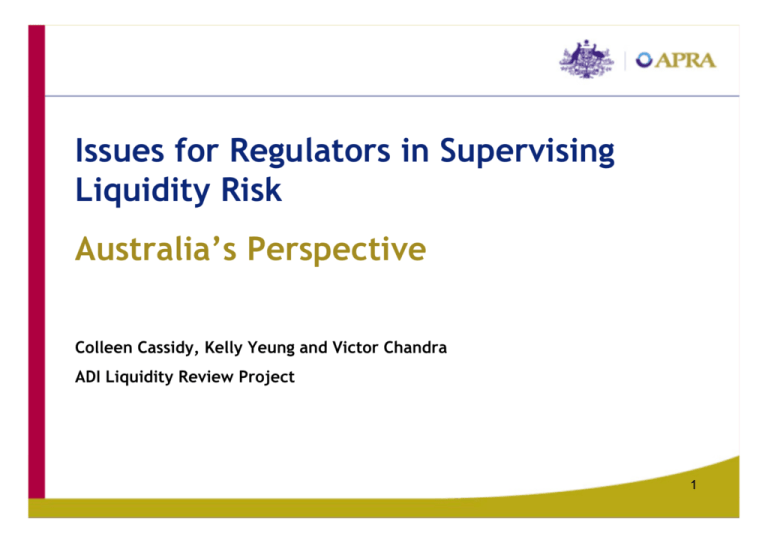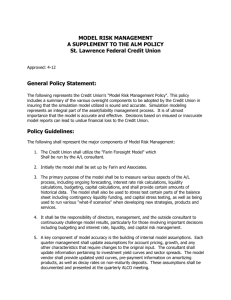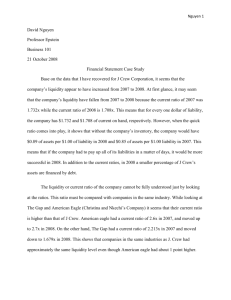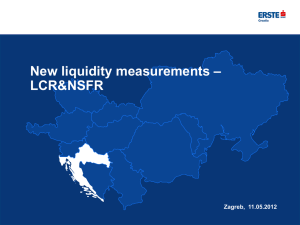APRA: Issues for regulators in supervising liquidity risk
advertisement

Issues for Regulators in Supervising Liquidity Risk Australia’s Perspective Colleen Cassidy, Kelly Yeung and Victor Chandra ADI Liquidity Review Project 1 Presentation outline • Structure of the Australian banking (ADI) industry • APRA’s approach to liquidity risk supervision • APRA’s liquidity project • Overview of regulatory approaches • Issues, challenges and ideas for change • Next steps 2 Structure of Australian banking (ADI) industry 3 APRA’s approach to liquidity risk supervision • Policy (APS 210) applies to all entity groups • Mix of qualitative and quantitative requirements • Qualitative requirements: o Liquidity management strategy and policy o Responsibilities of board and senior management o System and reporting requirements o Funding plans o Crisis management planning 4 APRA’s approach to liquidity risk supervision • Quantitative requirements: o Use one of two methods based on the sophistication of the ADI o Minimum Liquidity Holdings or Scenario Analysis 5 APRA’s approach to liquidity risk supervision • Minimum Liquidity Holdings Requirements: • 9% of liabilities in liquid assets • Liquid asset portfolio composition o cash o securities eligible for repurchase transactions with the central bank o other investment grade bank bills and CDs issued by ADIs o deposits (at call and any other deposits readily convertible into cash within two business days) held with other ADIs net of placements by the other ADIs o any other securities approved by APRA 6 APRA’s approach to liquidity risk supervision • Scenario Analysis Approach o At least two scenarios o Assumptions about cash flow behaviour • Going concern – the normal behaviour of cash flows • Name crisis – cash flow behaviour in adverse operating circumstances specific to the ADI, where the ADI has significant difficulty in rolling over or replacing its liabilities 7 Background to APRA’s liquidity project • Policy implemented in late 90s as a replacement to the prime asset requirement (the ‘PAR’ ratio) • Changing market conditions • Objective is to assess policy effectiveness • High level guidance - open to interpretation? 8 Background to APRA’s liquidity project 1. Issue identification and research • ADI practice • APRA practice • Overseas supervisor guidance 2. Determining recommendations – industry discussion paper in H2 2007 3. Drafting revised policy and guidance 9 Overview of regulatory approaches • Based on BCBS liquidity guidance – Sound Practices for Managing Liquidity in Banking Organisations (Feb 2000) – High level and non-prescriptive in nature – Focuses on qualitative aspects of liquidity risk management (13 principles for banks; 1 principle for supervisors) • Liquidity supervision approaches – Typically consist of 2 key elements: qualitative and quantitative requirements – Some supervisors only rely on qualitative requirements and do not impose quantitative requirements on banks 10 Overview of regulatory approaches • Qualitative requirements – Tend to be similar in scope across major developed countries – Reflect sound practices principles in BCBS liquidity guidance – Cover governance, systems and controls, liquidity scenario analysis/ stress testing, contingency planning, etc – Key difference: level of prescription required Supervisors in major developed countries (including Australia) tend to focus on principles-based requirements; some supervisors supplement these requirements with more detailed guidance for implementation purposes 11 Overview of regulatory approaches • Quantitative requirements – Significant divergence in approaches across countries – BCBS liquidity guidance allows supervisory discretion in setting quantitative requirements (e.g. minimum liquidity ratios or mismatch limits) – Various approaches: ¾ Liquidity stock approach vs. Cash flow/Maturity mismatch approach ¾ A mixture of liquidity stock and cash flow mismatch approach ¾ Apply cash flow mismatch approach to certain types of institutions and liquidity stock approach to others (e.g. UK and Australia) 12 Overview of regulatory approaches • Quantitative requirements: Liquidity stock approach – Countries using this approach: Hong Kong, Singapore and UK (UK retail banks) – Require banks to hold a minimum stock of eligible liquid assets at all times (typically expressed as a percentage of short-term liabilities) – Differences in supervisory requirements on minimum ratios, asset eligibility, valuation haircuts applied to liquid assets 13 Overview of regulatory approaches • Quantitative requirements: Cash flow/Maturity mismatch approach – Countries using this approach: UK (other banks), Ireland and Netherlands – Requires banks to forecast its cash flow mismatch positions for various time horizons – Differences in supervisory requirements on types of scenarios specified and process for setting behavioural cash flow assumptions 14 Issues, challenges and ideas for change • Developing appropriate prudential requirements and/or guidance that aims to maintain an appropriate balance between principles-based requirements and prescription – Qualitative requirements – Quantitative requirements 15 Issues, challenges and ideas for change 1. Application o Use of scenario analysis by which types of entity o Basis of assessment: group vs stand alone o Treatment of branches o Treatment of foreign currency 2. Liquid asset holdings o Definition of eligible liquid assets o How much? o Haircuts? 16 Issues, challenges and ideas for change Liquid asset holdings - Asset types to include? Cash and interbank deposits (convertible to cash in 2 days) 9 RBA repoable securities (Government securities, supranationals, bank bills and CDs) 9 Corporate paper ? Mortgage Backed Securities ? Asset Backed Securities ? FRNs ? 17 Issues, challenges and ideas for change 3. Models o Types of scenarios considered (market crisis scenario?) o Setting assumptions o Independent Review o Liquidity reporting • Customised reports vs. standardised returns • Report content differs significantly across scenario analysis ADIs (e.g. time bands and cash flow items covered in cash flow profiles) 18 Issues, challenges and ideas for change Name Crisis Assumptions Examples of assumptions used by banks • Retail call deposits - 5% of balances run-off over 5 days - 7.5% of balances run-off over 5 days - Greater of 5% run-off or 3 s.d. of historic withdrawal rates over 5 days - 5% run-off of remaining balances per day over 5 days • Other deposits - 15% of “quasi-retail” balances run-off over 5 days - 50% of “quasi-wholesale” balances run-off over 5 days - 100% of maturing “wholesale deposits” run-off over 5 days - 20% of “corporate deposit” balances run-off over 5 days • Undrawn commitments - 5% of unutilised facilities are drawn down over 5 days - 15% of unutilised facilities are drawn down over 5 days - $xx million are drawn down over 5 days 19 Issues, challenges and ideas for change Name Crisis Assumptions • Develop possible APRA guidance on run-off assumptions for key funding lines and committed facilities under a crisis scenario? Retail Deposits Minimum 5% run-off over 5 days Offshore and domestic interbank funding 100 % run-off of all maturing funds over the 5 day crisis period. No new funds can be obtained Offshore and domestic wholesale funding from established programs Where there is a demonstrated track record in issuing to a market segment, a lower run-off assumption is acceptable (50%) “Quasi-wholesale” domestic funding Run-off in the order of 15-30% over 5 days for long-standing relationship customer deposits Committed facilities 100% of undrawn portion of the committed facility unless historical drawdown rate can be estimated 20 Issues, challenges and ideas for change 4. Governance and organisational structures 5. Crisis management planning o Contingent funding sources o Certainty of standby facilities o Treatment of industry-based liquidity support arrangements 21 Issues, challenges and ideas for change Liquidity crisis contingency plan Bank A Bank B Bank C Bank D Identification of specific, measurable indicators of liquidity crisis 9 9 8 8 Procedures defining key roles & responsibilities for managing liquidity crisis 9 9 9 9 Communication plans to internal and external stakeholders 9 9 9 8 Assessment of priority, reliability, cost etc of contingent funding sources to manage liquidity stress scenarios 8 8 9 9 Testing liquidity crisis contingency planning document 9 8 8 8 Key elements 22 Next Steps • Work through issues • Policy and guidance drafting • Industry consultation 23









